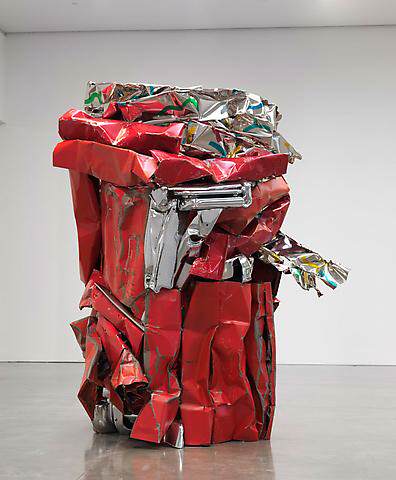
[vc_row][vc_column][vc_single_image image=”3813″ img_size=”full”][/vc_column][/vc_row][vc_row][vc_column][vc_empty_space height=”50px”][vc_column_text]John Chamberlain
New Works
Gagosian Gallery
6-24 Britannia Street, WC1X 9JD, London
+44 20 7841 9960
&
555 West 24th Street, NY 10011
+ 1212 741 1111
Chamberlain is best known for his distinctive metal sculptures, constructed from discarded automobile-body parts and other modern industrial detritus, which he began making in the late 1950s. His singular method of putting these elements together led to his inclusion in the paradigmatic exhibition The Art of Assemblage, at the Museum of Modern Art in 1961, where his work was shown alongside modern masters such as Marcel Duchamp and Pablo Picasso. While freely experimenting with other materials—from galvanized steel and paper bags to Plexiglas, foam rubber, and aluminum foil—he has consistently returned to metal car components, which he terms “art supplies.”
Chamberlain’s works boldly contrast the everyday, industrial origin of materials with a cumulative formal beauty, often underscored by the given paint finish of the constituents. The process of construction has its roots in industrial fabrication, given that mechanical car crushers often impart preliminary form to his raw materials. Visibly emphasizing the original seams as well as the physical trace of his actions, Chamberlain emphatically constructs assemblages that unite seemingly disparate mechanical elements. Crumpling, crushing, bending, twisting, painting, and welding the metals to form individual objects, which may be further sprayed, he combines them into aggregations, now on a monumental scale that is both imposing and thrilling. The new works are made of metal taken from mid-century American and European cars.
Chamberlain’s emphasis on discovered or spontaneous correlations between materials rather than a prescribed idea of composition have often prompted descriptions of his work as three-dimensional Abstract Expressionist paintings. The energetic lines created by the stacks of horizontal and vertical metal in HAWKFLIESAGAIN (2009) bring to mind the gestural approach of Jackson Pollock and Willem de Kooning, while the contrasting widths and muscular forms of various combined metal elements in STUFFEDWITHSURPRISE (2011) recalls the strong painterly stroke of Franz Kline. Chamberlain openly credits de Kooning, Kline, and David Smith as early influences on his own development. His sculptures are widely recognized as representing a major transition in the history of modern—particularly public—sculpture, when industrial materials became an acceptable,and, progressively, a preferred medium.[/vc_column_text][/vc_column][/vc_row][vc_row][vc_column][vc_empty_space height=”50px”][vc_single_image image=”3814″ img_size=”full”][vc_empty_space height=”50px”][vc_single_image image=”3815″ img_size=”full”][vc_empty_space height=”50px”][vc_single_image image=”3816″ img_size=”full”][vc_empty_space height=”50px”][vc_single_image image=”3817″ img_size=”full”][vc_empty_space height=”50px”][/vc_column][/vc_row][vc_row][vc_column][vc_column_text css_animation=”none” el_class=”with-link”]![]() back to ART DIARY[/vc_column_text][/vc_column][/vc_row]
back to ART DIARY[/vc_column_text][/vc_column][/vc_row]

Comments are closed.